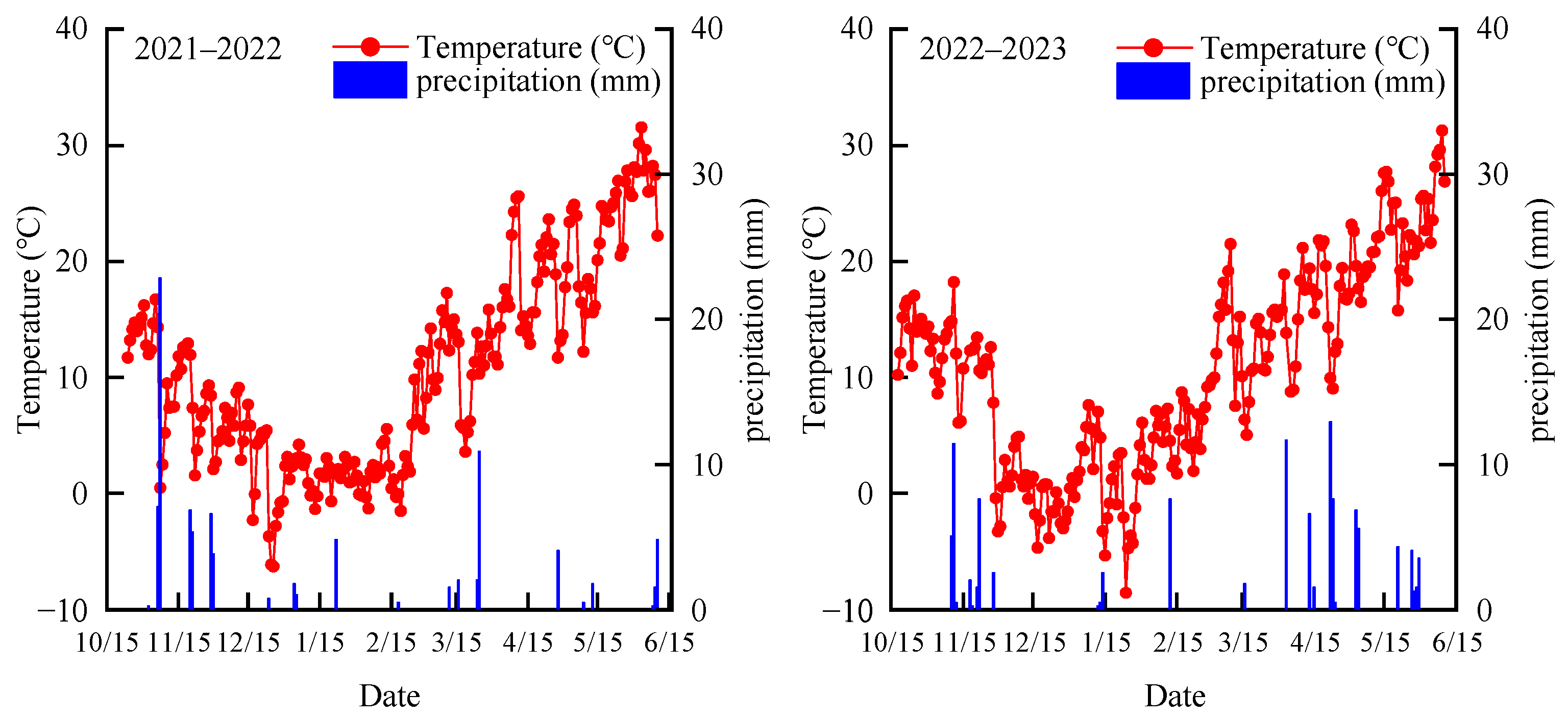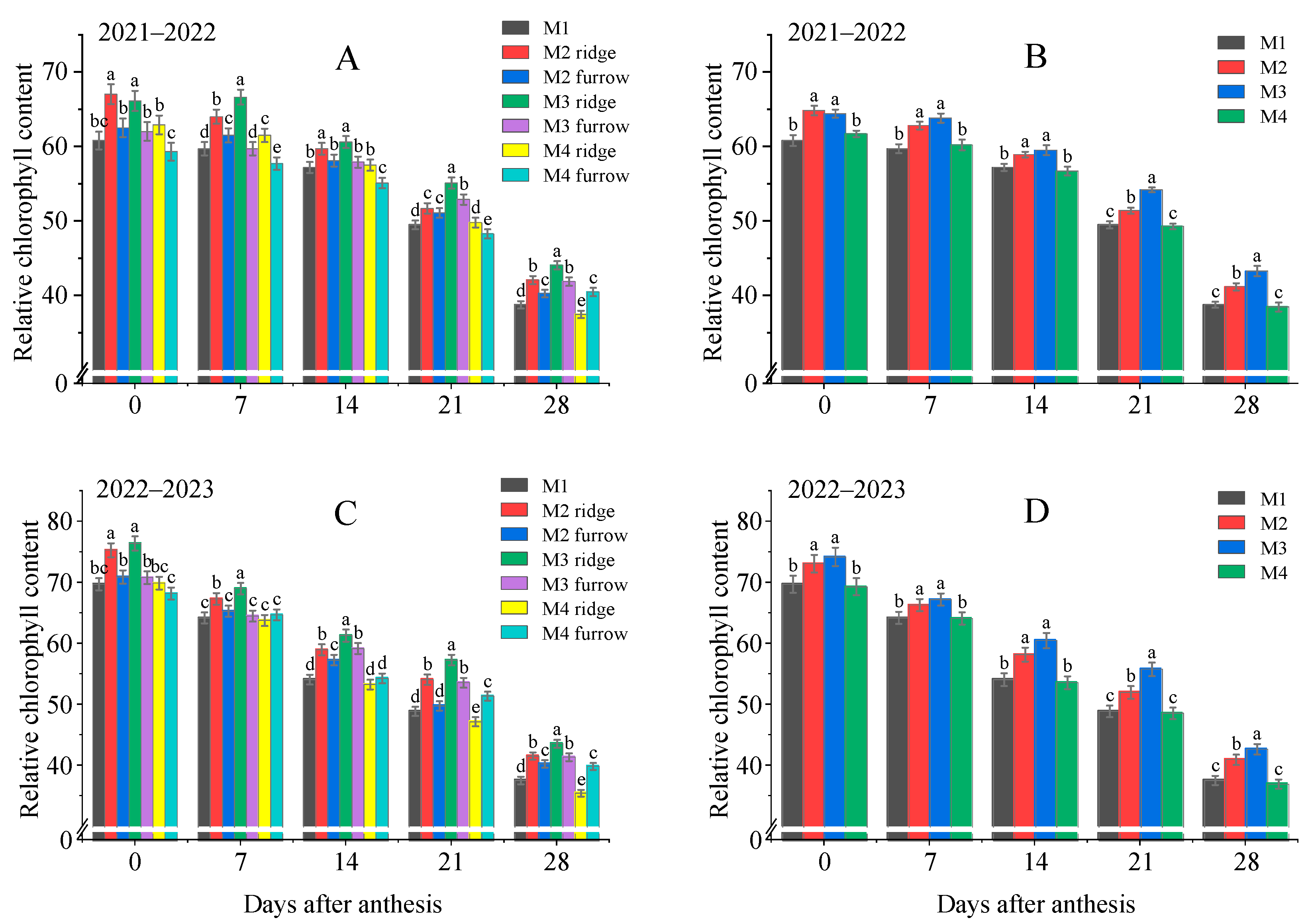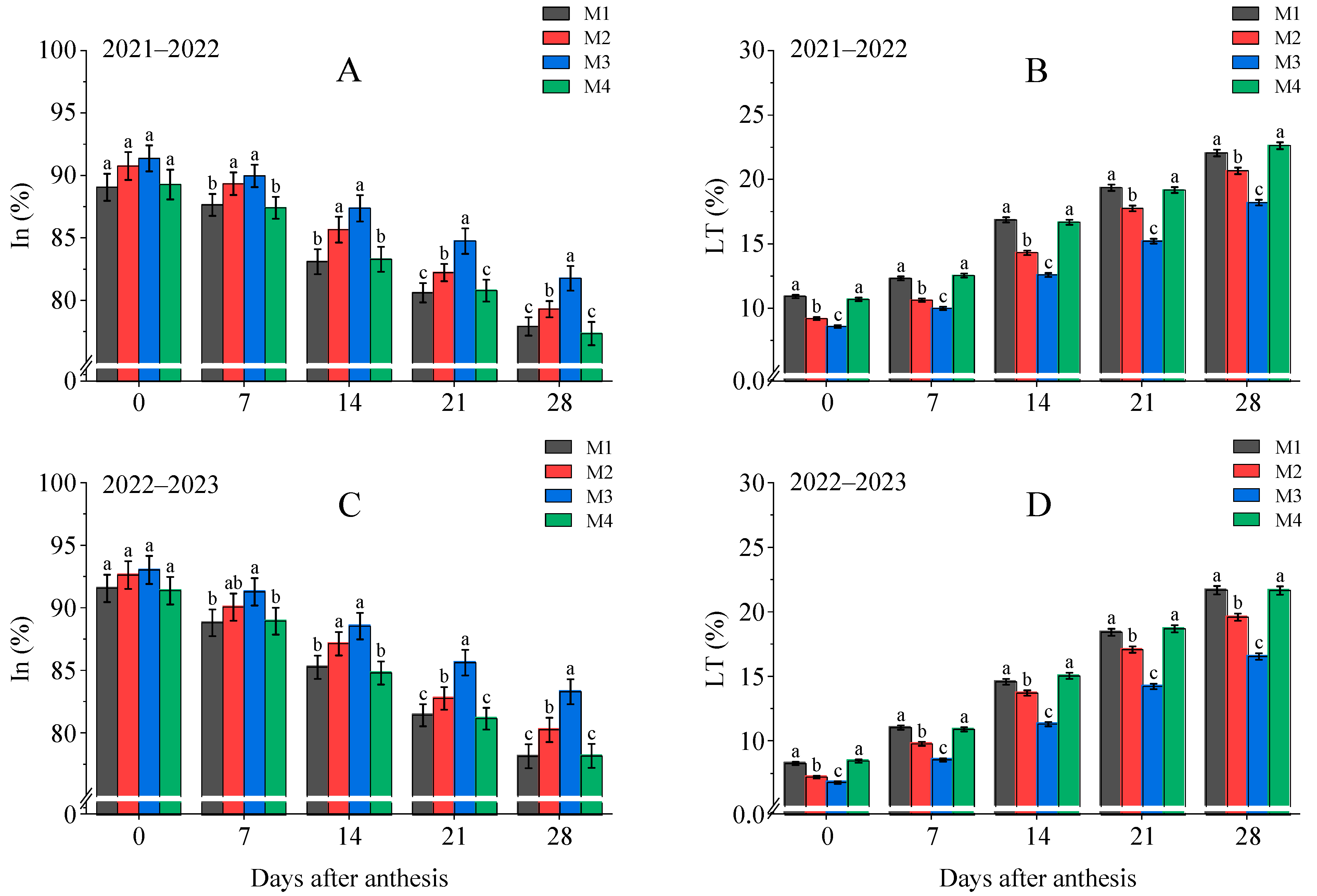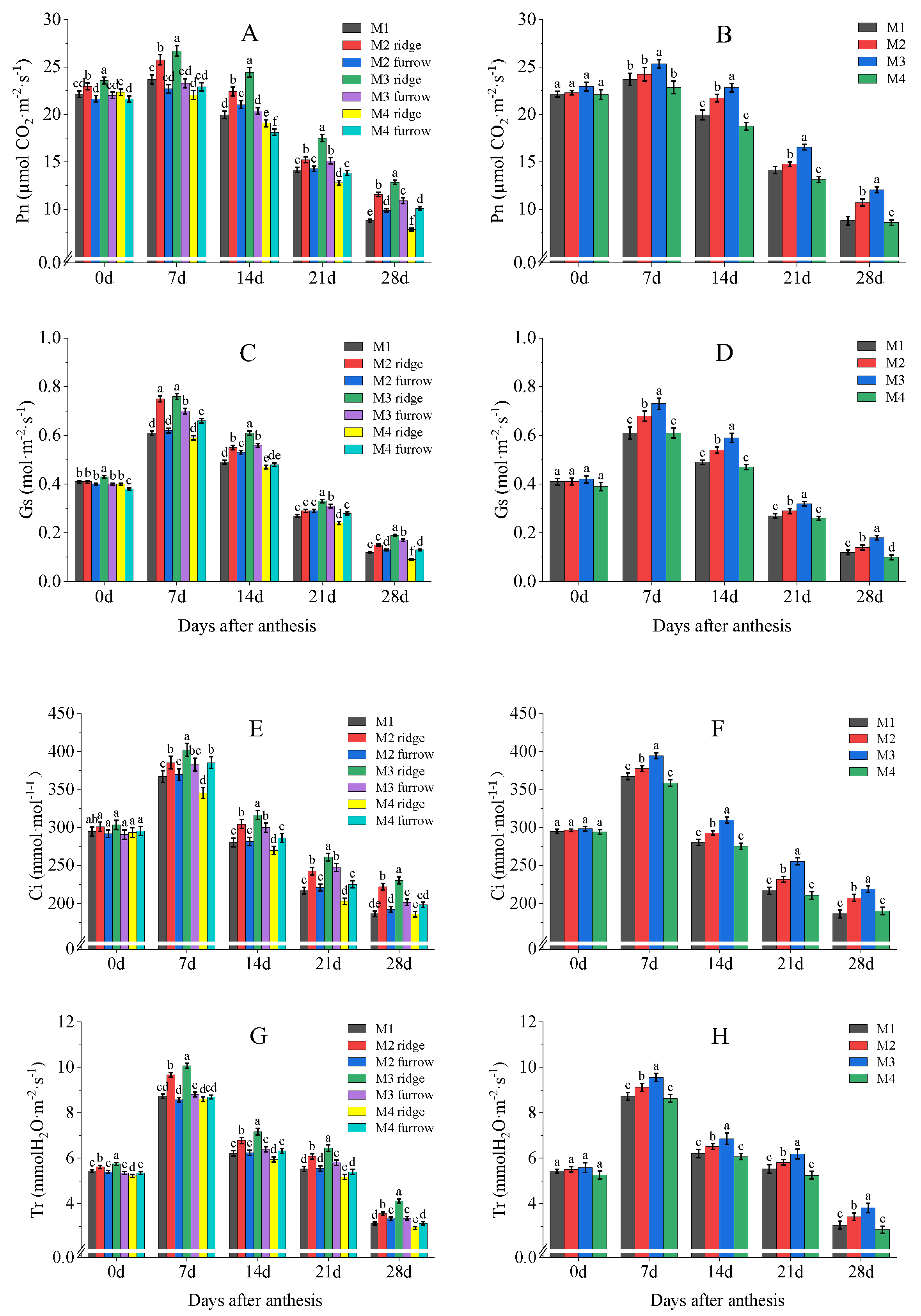Improving Photosynthesis and Grain Yield in Wheat through Ridge–Furrow Ratio Optimization
Abstract
:1. Introduction
2. Materials and Methods
2.1. Experimental Description and Experimental Design
2.2. Grain Yield Determination
2.3. Leaf Area Index (LAI)
2.4. Relative Chlorophyll Content (SPAD) of Flag Leaf
2.5. Canopy Light Interception Efficiency (In) and Transmittance (LT)
2.6. Photosynthetic Parameters of The Flag Leaf
2.7. Dry Matter Accumulation and Translocation
2.8. Data Analysis
3. Results
3.1. Yield and Yield Components
3.2. LAI
3.3. Flag Leaf SPAD Index
3.4. Canopy PAR In and LT
3.5. Photosynthetic Parameters of Flag Leaves
3.6. Accumulation and Translocation of Dry Matter at Pre- and Post-Anthesis Period
4. Discussion
4.1. Crop Yield and Yield Components
4.2. Canopy Development and Light Energy Capture
4.3. Photosynthetic Characteristics
4.4. Dry Matter Accumulation and Translocation
5. Conclusions
Author Contributions
Funding
Data Availability Statement
Acknowledgments
Conflicts of Interest
References
- Xu, X.X.; Liu, S.; Meng, F.G.; Zhang, X.; Zhao, J.K.; Qu, W.K.; Shi, Y.; Zhao, C.X. Grain yield formation and nitrogen utilization efficiency of different winter wheat varieties under rainfed conditions in the Huang-Huai-Hai Plain. Agronomy 2023, 13, 915. [Google Scholar] [CrossRef]
- Zhang, J.J.; Mu, J.Y.; Hu, Y.A.; Ren, A.X.; Lei, B.; Ding, P.C.; Li, L.H.; Sun, M.; Gao, Z.Q. Effect of Planting Patterns and Seeding Rate on Dryland Wheat Yield Formation and Water Use Efficiency on the Loess Plateau, China. Agronomy 2023, 13, 851. [Google Scholar] [CrossRef]
- Wu, F.Q.; Qiu, Y.R.; Huang, W.B.; Guo, S.M.; Han, Y.C.; Wang, G.P.; Li, X.F.; Lei, Y.P.; Yang, B.F.; Xiong, S.W.; et al. Water and heat resource utilization of cotton under different cropping patterns and their effects on crop biomass and yield formation. Agric. For. Meteorol. 2022, 323, 109091. [Google Scholar] [CrossRef]
- Ren, P.P.; Huang, F.; Li, B.G. Spatiotemporal patterns of water consumption and irrigation requirements of wheat-maize in the Huang-Huai-Hai Plain, China and options of their reduction. Agric. Water Manag. 2022, 263, 107468. [Google Scholar] [CrossRef]
- Gu, X.B.; Cai, H.J.; Chen, P.P.; Li, Y.P.; Fang, H.; Li, Y.N. Ridge-furrow film mulching improves water and nitrogen use efficiencies under reduced irrigation and nitrogen applications in wheat field. Field Crops Res. 2021, 270, 108214. [Google Scholar] [CrossRef]
- Zhang, Y.Y.; Zhao, X.N.; Wu, P.T. Soil Wetting Patterns and Water Distribution as Affected by Irrigation for Uncropped Ridges and Furrows. Pedosphere 2015, 25, 468–477. [Google Scholar] [CrossRef]
- Si, Z.Y.; Qin, A.Z.; Liang, Y.P.; Duan, A.W.; Gao, Y. A review on regulation of irrigation management on wheat physiology, grain yield, and quality. Plants 2023, 12, 692. [Google Scholar] [CrossRef]
- Fang, H.; Li, Y.N.; Gu, X.B.; Li, Y.P.; Chen, P.P. Can ridge-furrow with film and straw mulching improve wheat-maize system productivity and maintain soil fertility on the Loess Plateau of China? Agric. Water Manag. 2021, 246, 106686. [Google Scholar] [CrossRef]
- Liu, Y.; Zhang, X.L.; Xi, L.Y.; Liao, Y.C.; Han, J. Ridge-furrow planting promotes wheat grain yield and water productivity in the irrigated sub-humid region of China. Agric. Water Manag. 2020, 231, 105935. [Google Scholar] [CrossRef]
- Zhang, G.X.; Mo, F.; Shah, F.; Meng, W.H.; Liao, Y.C.; Han, J. Ridge-furrow configuration significantly improves soil water availability, crop water use efficiency, and grain yield in dryland agroecosystems of the Loess Plateau. Agric. Water Manag. 2021, 245, 106657. [Google Scholar] [CrossRef]
- Prasad, J.K.; Dillip, K.S.; Suhas, P.W. Developing climate change agro-adaptation strategies through field experiments and simulation analyses for sustainable sorghum production in semi-arid tropics of India. Agric. Water Manag. 2023, 286, 108399. [Google Scholar]
- Du, X.B.; He, W.C.; Wang, Z.; Xi, M.; Xu, Y.Z.; Wu, W.G.; Gao, S.Q.; Liu, D.; Lei, W.X.; Kong, L.C. Raised bed planting reduces waterlogging and increases yield in wheat following rice. Field Crops Res. 2021, 265, 108119. [Google Scholar] [CrossRef]
- Liu, J.M.; Si, Z.Y.; Wu, L.F.; Shen, X.J.; Gao, Y.; Duan, A.W. High-low seedbed cultivation drives the efficient utilization of key production resources and the improvement of wheat productivity in the North China Plain. Agric. Water Manag. 2023, 285, 108357. [Google Scholar] [CrossRef]
- Zhang, G.X.; Dai, R.C.; Ma, W.Z.; Fan, H.Z.; Meng, W.H.; Han, J.; Liao, Y.C. Optimizing the ridge-furrow ratio and nitrogen application rate can increase the grain yield and water use efficiency of rain-fed spring maize in the Loess Plateau region of China. Agric. Water Manag. 2022, 262, 107430. [Google Scholar] [CrossRef]
- Wu, G.; Ling, J.; Liu, Z.X.; Xu, Y.P.; Chen, X.M.; Wen, Y.; Zhou, S.L. Soil warming and straw return impacts on winter wheat phenology, photosynthesis, root growth, and grain yield in the North China Plain. Field Crops Res. 2022, 283, 108545. [Google Scholar] [CrossRef]
- Chang, T.G.; Shi, Z.; Zhao, H.L.; Song, Q.F.; He, Z.H.; Jeroen, V.R.; Bart, D.B.; Alexander, G.; Zhu, X.G. 3dCAP-Wheat: An Open-Source Comprehensive Computational Framework Precisely Quantifies Wheat Foliar, Nonfoliar, and Canopy Photosynthesis. Plant Phenomics 2022, 97, 58148. [Google Scholar] [CrossRef]
- Gao, Y.M.; Zhang, M.; Yao, C.S.; Liu, Y.Q.; Wang, Z.M.; Zhang, Y.H. Increasing seeding density under limited irrigation improves crop yield and water productivity of winter wheat by constructing a reasonable population architecture. Agric. Water Manag. 2021, 253, 106951. [Google Scholar] [CrossRef]
- Liu, F.S.; Song, Q.F.; Zhao, J.K.; Mao, L.X.; Bu, H.Y.; Hu, Y.; Zhu, X.G. Canopy occupation volume as an indicator of canopy photosynthetic capacity. New Phytol. 2021, 232, 941–956. [Google Scholar] [CrossRef]
- Shahzad, A.; Xu, Y.Y.; Irshad, A.; Jia, Q.M.; Ma, X.C.; Amir, S.; Manzoor; Muhammad, A.; Ren, X.L.; Cai, T.; et al. The ridge-furrow system combined with supplemental irrigation strategies to improves radiation use efficiency and winter wheat productivity in semi-arid regions of China. Agric. Water Manag. 2019, 213, 76–86. [Google Scholar]
- Jo, S.G.; Kang, Y.I.; Om, K.S.; Cha, Y.H.; Ri, S.Y. Growth, photosynthesis and yield of soybean in ridge-furrow intercropping system of soybean and flax. Field Crops Res. 2022, 275, 108329. [Google Scholar] [CrossRef]
- Dong, W.L.; Yu, H.; Zhang, L.Z.; Wang, R.N.; Wang, Q.; Xue, Q.W.; Pan, Z.H.; Sun, Z.G.; Pan, X.B. Asymmetric Ridge-Furrow and Film Cover Improves Plant Morphological Traits and Light Utilization in Rain-Fed Maize. J. Meteorol. Res. 2018, 32, 829–838. [Google Scholar] [CrossRef]
- Dai, Y.L.; Fan, J.L.; Liao, Z.Q.; Zhang, C.; Yu, J.; Feng, H.L.; Zhang, F.C.; Li, Z.J. Supplemental irrigation and modified plant density improved photosynthesis, grain yield and water productivity of winter wheat under ridge-furrow mulching. Agric. Water Manag. 2022, 274, 107985. [Google Scholar] [CrossRef]
- Du, X.B.; Wang, Z.; Xi, M.; Wu, W.G.; Wei, Z.; Xu, Y.Z.; Zhou, Y.J.; Lei, W.X.; Kong, L.C. A novel planting pattern increases the grain yield of wheat after rice cultivation by improving radiation resource utilization. Agric. For. Meteorol. 2021, 310, 108625. [Google Scholar] [CrossRef]
- Han, Y.j.; Wang, Y.C.; Zhang, D.M.; Gao, H.; Sun, Y.; Tao, B.; Zhang, F.Y.; Ma, H.; Liu, X.M.; Ren, H.L. Planting models and deficit irrigation strategies to improve radiation use efficiency, dry matter translocation and winter wheat productivity under semi-arid regions. J. Plant Physiol. 2023, 280, 153864. [Google Scholar] [CrossRef] [PubMed]
- Liu, T.N.; Chen, J.Z.; Wang, Z.Y.; Wu, X.R.; Wu, X.C.; Ding, R.X.; Han, Q.F.; Cai, T.; Jia, Z.K. Ridge and furrow planting pattern optimizes canopy structure of summer maize and obtains higher grain yield. Field Crops Res. 2018, 219, 242–249. [Google Scholar] [CrossRef]
- Liu, P.; Wang, H.l.; Li, L.C.; Liu, X.L.; Qian, R.; Wang, J.J.; Yan, X.Q.; Cai, T.; Zhang, P.; Jia, Z.K.; et al. Ridge-furrow mulching system regulates hydrothermal conditions to promote maize yield and efficient water use in rainfed farming area. Agric. Water Manag. 2020, 232, 106041. [Google Scholar] [CrossRef]
- Si, Z.Y.; Liu, J.M.; Wu, L.F.; Li, S.; Wang, G.S.; Yu, J.C.; Gao, Y.; Duan, A.W. A high-yield and high-efficiency cultivation pattern of winter wheat in North China Plain: High-low seedbed cultivation. Field Crops Res. 2023, 300, 109010. [Google Scholar] [CrossRef]
- Han, Y.Y.; Wang, Y.G.; Zhou, B.X.; Chen, Y.H.; Liu, P. Radiation use efficiency and yield response of winter wheat to planting patterns and irrigation in Northern China. Agron. J. 2014, 106, 168–174. [Google Scholar] [CrossRef]
- Shahzad, A.; Xu, Y.Y.; Jia, Q.M.; Ma, X.C.; Irshad, A.; Muhammad, A.; Rushingabigwi, G.; Ren, X.L.; Zhang, P.; Cai, T.; et al. Interactive effects of plastic film mulching with supplemental irrigation on winter wheat photosynthesis, chlorophyll fluorescence and yield under simulated precipitation conditions. Agric. Water Manag. 2018, 207, 1–14. [Google Scholar]
- Fan, Y.H.; Lv, Z.Y.; Qin, B.Y.; Yang, J.H.; Ren, K.M.; Liu, Q.X.; Jiang, F.Y.; Zhang, W.J.; Ma, S.Y.; Ma, C.X.; et al. Night warming at the vegetative stage improves pre-anthesis photosynthesis and plant productivity involved in grain yield of winter wheat. Plant Physiol. Biochem. 2022, 186, 19–30. [Google Scholar] [CrossRef]
- Nader, M.O. An improved weighted average simulation approach for solving reliability-based analysis and design optimization problems. Struct. Saf. 2016, 60, 47–55. [Google Scholar]
- Liu, P.J.; Zhang, T.; Zhang, F.Y.; Ren, X.L.; Chen, X.L.; Zhao, X.N. Ridge cropping and furrow irrigation pattern improved spring maize (Zea mays L.) yield and water productivity in Hetao irrigation area of Northwestern China. J. Sci. Food Agric. 2022, 102, 6889–6898. [Google Scholar] [CrossRef] [PubMed]
- Cui, Z.J.; Gao, Y.H.; Guo, L.Z.; Wu, B.; Yan, B.; Wang, Y.F.; Liu, H.S.; Li, G.; Wang, Y.Z.; Wang, H.D. Optimal effects of combined application of nitrate and ammonium nitrogen fertilizers with a ratio of 3:1 on grain yield and water use efficiency of maize sowed in ridge-furrow plastic film mulching in Northwest China. Agronomy 2022, 12, 2943. [Google Scholar] [CrossRef]
- Qiang, S.C.; Zhang, Y.; Fan, J.L.; Zhang, F.C.; Sun, M.; Gao, Z.Q. Combined effects of ridge-furrow ratio and urea type on grain yield and water productivity of rainfed winter wheat on the Loess Plateau of China. Agric. Water Manag. 2022, 261, 107340. [Google Scholar] [CrossRef]
- Li, W.W.; Xiong, L.; Wang, C.J.; Liao, Y.C.; Wu, W. Optimized ridge-furrow with plastic film mulching system to use precipitation efficiently for winter wheat production in dry semi-humid areas. Agric. Water Manag. 2019, 218, 211–221. [Google Scholar] [CrossRef]
- Du, X.B.; Wei, Z.; Kong, L.C.; Zhang, L.G. Optimal bed width for wheat following rice production with raised-bed planting in the Yangtze River Plain of China. Agric. Water Manag. 2022, 269, 107676. [Google Scholar] [CrossRef]
- Luo, C.L.; Zhang, X.F.; Duan, H.X.; Zhou, R.; Mo, F.; Mburu, D.M.; Wang, B.Z.; Wang, W.; Kavagi, L.; Xiong, Y.C. Responses of rainfed wheat productivity to varying ridge-furrow size and ratio in semiarid eastern African Plateau. Agric. Water Manag. 2021, 249, 106813. [Google Scholar] [CrossRef]
- Du, X.B.; Xi, M.; Wei, Z.; Chen, X.F.; Wu, W.G.; Kong, L.C. Raised bed planting promotes grain number per spike in wheat grown after rice by improving spike differentiation and enhancing photosynthetic capacity. J. Integr. Agric. 2023, 22, 1631–1644. [Google Scholar] [CrossRef]
- Zhang, X.D.; Kamran, M.; Xue, X.K.; Zhao, J.; Cai, T.; Jia, Z.K.; Zhang, P.; Han, Q.F. Ridge-furrow mulching system drives the efficient utilization of key production resources and the improvement of maize productivity in the Loess Plateau of China. Soil Tillage Res. 2019, 190, 10–21. [Google Scholar] [CrossRef]
- Zheng, H.Y.; Wang, J.Y.; Cui, Y.; Guan, Z.Y.; Yang, L.; Tang, Q.Q.; Sun, Y.F.; Yang, H.S.; Wen, X.Q.; Mei, N.; et al. Effects of Row Spacing and Planting Pattern on Photosynthesis, Chlorophyll Fluorescence, and Related Enzyme Activities of Maize Ear Leaf in Maize-Soybean Intercropping. Agronomy 2022, 12, 2503. [Google Scholar] [CrossRef]
- Ma, S.T.; Mei, F.J.; Wang, T.C.; Liu, Z.D.; Ma, S.C. Stereoscopic Planting in Ridge and Furrow Increases Grain Yield of Maize (Zea mays L.) by Reducing the Plant’s Competition for Water and Light Resources. Agriculture 2021, 12, 20. [Google Scholar] [CrossRef]
- Ru, C.; Wang, K.F.; Hu, X.T.; Chen, D.Y.; Wang, W.E.; Yang, H.S. Nitrogen Modulates the Effects of Heat, Drought, and Combined Stresses on Photosynthesis, Antioxidant Capacity, Cell Osmoregulation, and Grain Yield in Winter Wheat. J. Plant Growth Regul. 2022, 42, 1681–1703. [Google Scholar] [CrossRef]
- Ren, X.-L.; Zhang, P.; Chen, X.-L.; Jia, Z.-K. Impacts of ridge-furrow rainfall concentration systems and mulches on corn growth and yield in the semiarid region of China. J. Sci. Food Agric. 2016, 96, 3882–3889. [Google Scholar] [CrossRef] [PubMed]
- Fang, H.; Liu, F.L.; Gu, X.B.; Chen, P.P.; Li, Y.P.; Li, Y.N. The effect of source-sink on yield and water use of winter wheat under ridge-furrow with film mulching and nitrogen fertilization. Agric. Water Manag. 2022, 267, 107616. [Google Scholar] [CrossRef]
- Liu, X.L.; Wang, Y.D.; Yan, X.Q.; Hou, H.Z.; Liu, P.; Cai, T.; Zhang, P.; Jia, Z.K.; Ren, X.L.; Chen, X.L. Appropriate ridge-furrow ratio can enhance crop production and resource use efficiency by improving soil moisture and thermal condition in a semi-arid region. Agric. Water Manag. 2020, 240, 106289. [Google Scholar] [CrossRef]
- Zhao, W.H.; Liu, L.Z.; Shen, Q.; Yang, J.H.; Han, X.Y.; Tian, F.; Wu, J.J. Effects of Water Stress on Photosynthesis, Yield, and Water Use Efficiency in Winter Wheat. Water 2020, 12, 2127. [Google Scholar] [CrossRef]





| Year | Treatment | Plot Irrigation Amount | Irrigation at Jointing | Irrigation at Anthesis | Total Irrigation | |
|---|---|---|---|---|---|---|
| Jointing | Anthesis | |||||
| (m3) | (m3) | (mm) | (mm) | (mm) | ||
| 2021–2022 | M1 | 13.57 | 11.31 | 75.4 | 62.83 | 138.23 |
| M2 | 11.63 | 9.56 | 64.6 | 53.1 | 117.7 | |
| M3 | 10.37 | 8.16 | 57.6 | 45.34 | 102.94 | |
| M4 | 9.09 | 7.16 | 50.51 | 39.78 | 90.29 | |
| 2022–2023 | M1 | 7.96 | 6.80 | 44.23 | 37.78 | 82.02 |
| M2 | 5.80 | 5.88 | 32.23 | 32.67 | 64.9 | |
| M3 | 5.16 | 5.23 | 28.68 | 29.07 | 57.75 | |
| M4 | 4.78 | 4.86 | 26.57 | 27 | 53.57 | |
| Year | Treatment | Spike Number (104·ha−1) | Mean | Kernel Number per Spike | Mean | Thousand Kernel Weight (g) | Mean | Yield (kg·ha−1) | Mean | |
|---|---|---|---|---|---|---|---|---|---|---|
| 2021–2022 | M1 | - | 657.9 c | 657.9 b | 36.91 bc | 36.91 a | 44.38 d | 44.38 c | 9101 b | 9101 c |
| M2 | ridge | 654.6 c | 658.6 b | 37.30 ab | 37.35 a | 47.46 b | 45.68 b | 9813 a | 9505 b | |
| furrow | 662.6 c | 37.40 ab | 43.89 d | 9197 b | ||||||
| M3 | ridge | 663.5 c | 675.2 a | 36.23 c | 37.19 a | 48.50 a | 45.99 a | 9851 a | 9802 a | |
| furrow | 692.7 b | 38.23 a | 43.53 d | 9730 a | ||||||
| M4 | ridge | 605.2 d | 642.6 c | 36.70 bc | 36.50 a | 45.44 c | 45.74 c | 8644 c | 9019 c | |
| furrow | 717.5 a | 38.11 a | 42.33 e | 9769 a | ||||||
| 2022–2023 | M1 | - | 612.1 bc | 612.1 b | 40.20 a | 40.20 a | 40.45 d | 40.45 c | 8538 c | 8538 c |
| M2 | ridge | 604.9 c | 614.9 b | 40.64 a | 40.23 a | 44.05 b | 42.10 b | 9270 b | 8927 b | |
| furrow | 624.9 b | 39.81 a | 40.15 d | 8584 c | ||||||
| M3 | ridge | 613.4 bc | 631.5 a | 40.24 a | 39.90 a | 46.12 a | 43.59 a | 9707 a | 9355 a | |
| furrow | 658.7 a | 39.40 a | 39.80 d | 8827 b | ||||||
| M4 | ridge | 548.4 d | 588.4 c | 39.84 a | 39.67 a | 43.12 c | 42.05 b | 8148 d | 8435 c | |
| furrow | 668.4 a | 39.32 a | 39.90 d | 9009 b | ||||||
| Year | Treatment | Days after Anthesis | ||||||||||
|---|---|---|---|---|---|---|---|---|---|---|---|---|
| 0 | Mean | 7 | Mean | 14 | Mean | 21 | Mean | 28 | Mean | |||
| 2021–2022 | M1 | - | 6.14 c | 6.14 b | 5.75 c | 5.75 c | 5.13 d | 5.13 c | 3.38 d | 3.38 c | 2.35 c | 2.25 c |
| M2 | ridge | 6.15 c | 6.30 a | 5.84 c | 6.06 b | 5.24 d | 5.54 b | 3.53 c | 3.54 b | 2.33 c | 2.49 b | |
| furrow | 6.44 b | 6.27 a | 5.84 b | 3.54 c | 2.65 b | |||||||
| M3 | ridge | 6.18 c | 6.34 a | 6.02 b | 6.16 a | 5.66 c | 5.98 a | 3.62 c | 3.97 a | 2.60 b | 3.08 a | |
| furrow | 6.59 ab | 6.36 a | 6.15 a | 4.04 b | 3.21 a | |||||||
| M4 | ridge | 5.88 d | 6.16 b | 5.56 d | 5.82 c | 4.62 e | 5.08 c | 2.74 e | 3.37 c | 1.72 d | 2.20 d | |
| furrow | 6.72 a | 6.33 a | 6.01 a | 4.42 a | 3.15 a | |||||||
| 2022–2023 | M1 | - | 6.18 b | 6.18 a | 5.82 d | 5.82 b | 5.23 d | 5.23 c | 4.24 d | 4.24 c | 2.84 c | 2.84 c |
| M2 | ridge | 6.20 b | 6.31 a | 5.87 d | 6.04 a | 5.22 d | 5.40 b | 4.21 d | 4.37 b | 2.81 c | 2.97 b | |
| furrow | 6.41 b | 6.21 b | 5.57 c | 4.52 c | 3.12 b | |||||||
| M3 | ridge | 6.26 b | 6.41 a | 6.05 c | 6.19 a | 5.43 c | 5.62 a | 4.40 c | 4.60 a | 3.07 b | 3.16 a | |
| furrow | 6.64 a | 6.41 a | 5.90 b | 4.90 b | 3.30 a | |||||||
| M4 | ridge | 5.93 c | 6.18 a | 5.48 e | 5.83 b | 4.77 e | 5.22 c | 3.78 e | 4.22 c | 2.61 d | 2.83 c | |
| furrow | 6.67 a | 6.54 a | 6.13 a | 5.11 a | 3.28 a | |||||||
| Treatment | Anthesis (kg·ha−1) | Mean | Maturity (kg·ha−1) | Mean | Pre-Anthesis Storage of Assimilates | Post-Anthesis Assimilates | |||||||
|---|---|---|---|---|---|---|---|---|---|---|---|---|---|
| Translocation (kg·ha−1) | Mean | Contribution Rate to Grain (%) | Mean | Accumulation (kg·ha−1) | Mean | Contribution Rate to Grain (%) | Mean | ||||||
| M1 | - | 13,085 c | 13,085 a | 19,218 a | 19,218 b | 2702 c | 2702 a | 30.60 b | 30.60 a | 6133 d | 6133 c | 69.40 c | 69.40 b |
| M2 | ridge | 12,621 c | 12,829 a | 19,312 c | 19,385 b | 3044 a | 2764 a | 31.27 a | 29.59 b | 6691 b | 6557 b | 68.73 c | 70.41 ab |
| furrow | 13,036 c | 19,458 c | 2484 d | 27.90 d | 6422 c | 72.10 ab | |||||||
| M3 | ridge | 12,740 c | 13,139 a | 19,596 c | 20,003 a | 2904 b | 2721 a | 29.76 c | 28.35 c | 6856 a | 6864 a | 70.24 bc | 71.65 a |
| furrow | 13,737 b | 20,614 b | 2447 d | 26.25 e | 6876 a | 73.75 a | |||||||
| M4 | ridge | 11,384 d | 12,444 b | 17,148 d | 18,511 c | 2669 c | 2691 a | 31.68 a | 30.81 a | 5763 e | 6068 c | 68.32 c | 69.19 b |
| furrow | 14,562 a | 21,238 a | 2734 c | 29.07 c | 6676 b | 70.93 bc | |||||||
Disclaimer/Publisher’s Note: The statements, opinions and data contained in all publications are solely those of the individual author(s) and contributor(s) and not of MDPI and/or the editor(s). MDPI and/or the editor(s) disclaim responsibility for any injury to people or property resulting from any ideas, methods, instructions or products referred to in the content. |
© 2023 by the authors. Licensee MDPI, Basel, Switzerland. This article is an open access article distributed under the terms and conditions of the Creative Commons Attribution (CC BY) license (https://creativecommons.org/licenses/by/4.0/).
Share and Cite
Liu, K.; Shi, Y.; Yu, Z.; Zhang, Z.; Zhang, Y. Improving Photosynthesis and Grain Yield in Wheat through Ridge–Furrow Ratio Optimization. Agronomy 2023, 13, 2413. https://doi.org/10.3390/agronomy13092413
Liu K, Shi Y, Yu Z, Zhang Z, Zhang Y. Improving Photosynthesis and Grain Yield in Wheat through Ridge–Furrow Ratio Optimization. Agronomy. 2023; 13(9):2413. https://doi.org/10.3390/agronomy13092413
Chicago/Turabian StyleLiu, Kun, Yu Shi, Zhenwen Yu, Zhen Zhang, and Yongli Zhang. 2023. "Improving Photosynthesis and Grain Yield in Wheat through Ridge–Furrow Ratio Optimization" Agronomy 13, no. 9: 2413. https://doi.org/10.3390/agronomy13092413




